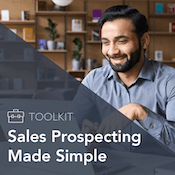Once upon a time, there was a notion that social media was unnecessary for selling; it was a novelty and not a staple. At the time, some believed that enterprise-level decision makers couldn’t be reached on social platforms.
Now, social media is a necessity to establish credibility with potential buyers.
In fact, 82% of buyers look up a seller on LinkedIn before replying to their outreach efforts. LinkedIn and Twitter have become core platforms to supplement a seller’s prospecting efforts.
And while Twitter may be less personal, the low barrier to entry means it’s easy to get content in front of relevant people, make connections, and begin conversations.
Today, social isn’t a trend, it’s a core component of selling and a key part of your prospecting activities.
What Is Social Selling?
Social selling is when sellers use social media (e.g., LinkedIn, Twitter, Facebook, Instagram) to find and engage with potential buyers, decision makers, and influencers.
This goes well beyond direct outreach to set meetings or pitch products or services.
Instead, the best social sellers build and strengthen relationships with people and provide value from the start. They don’t jump right to a sales pitch, which risks immediately alienating people. In fact, it takes an average of 8 touches to generate a conversion.
Social selling may be a means of reaching more people, but it isn’t a panacea. It won’t magically make you any better at the basics of selling, such as connecting with buyers, uncovering needs, demonstrating impact, overcoming objections, or presenting compelling solutions. Nor does posting a couple of times per week mean prospects will flock to your DMs.
Social selling doesn’t exist in a vacuum. It’s a means of building relationships to supplement existing sales activities.
Over time you can curate a combination of branded and non-branded content to establish your's and your organization’s expertise and build awareness. Increasing your online presence and credibility will support your outreach efforts, as well as generate inbound leads.
The Difference Between Social Selling and Social Marketing
Note that social selling is similar to, but distinct from, social marketing. While social marketing campaigns are about widespread exposure, social selling deals with the direct relationships established with potential buyers.
Think about it like this: social marketing is one to many, while social selling is one-to-one.
Using Social Media for Sales Research
In addition to buyer engagement, social media presents opportunities for preliminary sales research.
Sellers have a huge opportunity to take advantage of the vast amounts of information about their buyers that's available on social media. Buyers want sellers to be informed about their industries and be able to bring them new insights. Social media is an excellent tool to keep you abreast of changes, identify trigger events, and uncover areas of commonality with your buyers.
Whether you're researching new prospective buyers before reaching out, a buyer before a sales conversation, or a target industry, social media should be one of the first places you look. Before you even reach out to a prospect, focus on these 5 areas when conducting research.
1. Buyer Information
Learn where individual buyers went to school, see their work history, identify the groups they're a part of, and what causes they care about. Find shared connections and potential referral or introduction sources.
Social media provides a treasure trove of buyer information if you take the time to look.
Use that information to build strong connections and rapport with buyers. After all, rapport is essential for sales success, and a key way to build rapport is to find common interests with buyers.
2. Company Information
It's important to know what's going on in your buyer's organization. Social media provides up-to-the-minute news about the company. See what they're publishing and who's talking about them.
3. Trigger Events
Did the company recently hire a new CEO? Is it expanding into new markets? Did it miss its quarterly targets? Is it launching a new product or service line? Was it recently featured in an industry or business article? Did one of your contacts move to a new company?
Social media allows you to uncover trigger events you may not have otherwise found. A trigger event gives you an opportunity to reach out if you have something valuable to add to the conversation.
For example, if a target company falls short of its quarterly earnings because of a sales shortfall, and that's something you can help with, you can reach out. Use the event as an opportunity to introduce yourself and share ideas and practical advice for how to reverse this trend.
4. Industry Trends
Major industry trends offer opportunities to either help a client capitalize on the trend or avoid risk. Industry trends could be something big, like new legislation, availability of raw materials, or compliance issues, or something small, such as an important industry event, award, or entrant in the market.
Any change can lead to a sales opportunity for you. Industry changes also allow you to reach out to your current clients to discuss how they're positioned to handle it. Doing so strengthens the relationship by demonstrating your proactivity and expertise in their field and can create new opportunities to grow your existing accounts.
Follow industry news and key industry publications to stay on top of what's going on.
5. Competitive Information
Where your clients and buyers stand in relation to their competitors is important information. Maybe a competitor of your buyer just a won a large new client, or is expanding, or won an important award.
By following social media profiles of those in the industry, including key competitors of your clients and buyers, you can identify competitive threats and opportunities and bring those to the fore.
4 Reasons Why Social Selling Is Important
Sellers who get on board with social selling can see numerous benefits.
1. Reach Prospects Where They Live
Social selling makes it easier to identify better prospects by engaging an audience that's already interested in what you have to say. And you can be confident that prospects can be found on social media. An IDC survey found a whopping 75% of B2B buyers use social media to make their purchasing decisions.
2. Save Time and Energy
Cultivating awareness through social media empowers sellers to focus on the most interested and engaged prospects. This generates better returns than cold calling. It also saves you time and energy lost chasing prospects that lead nowhere, so you can have more time for the things that matter most in your schedule.
3. Outsell the Competition
Like it or not, social selling has cemented itself as a part of sales. LinkedIn’s Social Selling Index provides a score of 0-100 based on a user’s sales activities on the platform. With this data, they found that 78% of social sellers outsell those who don’t use social media.
4. Build Your Credibility
In a media-saturated world, what’s the best way to stand out among the noise? Credibility! Establishing credibility is already an important step toward building trust with a prospect. Through social media, this can be built up over an extended period of time and organically grow your personal brand.
According to LinkedIn, 92% of B2B buyers are willing to engage with a known industry thought leader.
8 Tips and Best Practices for Social Selling
There’s no single way to approach social selling, and each seller may engage differently depending on their situation and existing brand recognition. However, the following social selling tips can get you started and save you from common pitfalls.
1. Boil the Frog
There’s an old tale that if you put a frog in boiling water, it will sense the heat and jump out. But if you put a frog in cool water and turn up the heat slowly, the frog won't notice. While this has been disproven, the phrase “boil the frog” is still relevant when it comes to social selling.
When reaching out to people you’d like to speak with, start small and authentic. Nothing screams “jump out of the hot pot” more than a blatant “talk to me so I can sell you something” message.
Start cool and warm up slowly. Comment on buyers’ posts. Retweet them when relevant. Compliment something they wrote. Become familiar to someone—even if they don’t engage you right away—and it’s more likely they’ll engage with you in the future.
Remember, this isn’t marketing. Your initial interactions shouldn’t have a pitch or even a promotion attached. This aspect of social selling is more akin to online networking.
2. Givers Gain
The world of social media changes fast. But some things never change—like the golden rule of networking (social or otherwise).
The golden rule? Givers gain.
As Dr. Robert Cialdini wrote, “If we seek out and give help to a team member, colleague, or acquaintance, we create a social obligation for that person to help us or support us at a future date.”
How do you do that in social selling? Share a white paper or ebook. Share a relevant piece of research. Provide content that’s 100% customized to the individual’s situation. Offer to make a connection or a referral. And so on.
Buyers Want Insight
The content that most influences buyers’ decision to accept a meeting or otherwise connect with a seller, according to buyers, includes:
- Primary research data: 69%
- Content 100% customized to our specific situation: 67%
- Best-practice methodology: 65%
- Insight into new and emerging business issues or market trends: 63%
- Client case studies and success stores: 61%
- How-to tips, tactics, and advice: 56%
Share valuable insights and buyers will want to connect with you.
Source: Top Performance in Sales Prospecting, RAIN Group Center for Sales Research
Remember, starting relationships can take many touch points. Do this right and people will perceive you as valuable even before you interact with them personally.
3. Strive to Make Connections
When reaching out through social media, don’t settle for anything less than your best work.
The standard “my products would be of value” overture doesn’t catch anyone’s attention. It doesn’t create any personalization or genuine connection. Occasionally, you’ll encounter someone who puts effort into establishing a connection, and it shows.
Be like these people. Find common ground, customize your outreach, and list reasons why people would want to connect and speak with you.
4. Be Brave
Call reluctance is common on the phone. It happens online, too. People don’t reach out online out of fear. "They won’t respond." "They’ll say no." "They’ll be angry with me."
The fact is, 82% of buyers accept meetings with sellers who reach out.
In the online world, there’s a heavy emphasis on the concept of inbound marketing. And it’s easy to see why: it’s a proven approach. Ideally, all your prospects would come to you. But the saturation of advertising and promotion in online spaces makes proactive outreach necessary as part of a larger sales strategy.
It starts by identifying who to contact. Social selling helps immensely with the first stages of lead qualification. When you find a particular person you want to connect with, reach out.
As long as you keep these points in mind, you’ll be fine. As business guru Wayne Gretzky said, “You miss 100% of the shots you don’t take.”
Be brave. Take shots.
5. Be Positive and Pleasant
When some people prepare to reach out to leads, they think, "I’m about to reach out to a big-time person. I need to seem big time too!" So they puff out their chest and brag about how awesome they are.
Authenticity is a difficult thing to achieve deliberately, and prospects can sense “salesy” behavior from a mile away. There’s no need for self-importance, as this is one of the fastest ways to push a lead away.
Instead, focus on your lead and how you can be helpful to them. Todd Schnick said it well: “Actions make you influential. Not your words or tweets. People who serve, people who help others, people who share the cool things that others are doing… those are the actions that make you influential.”
Right on, Todd.
6. Prepare for Window Shopping
When you reach out to people, expect them to check you out. When someone writes to me and I’m curious, the first thing I do is Google them and see what comes up. And the options for learning more about somebody’s life and career have only multiplied in recent years.
Make sure when the people you’re reaching out to search for you online, you’re portrayed exactly how you want to be. Determine how your personal brand and online reputation come across—it greatly affects people’s impressions of you.
You should be aware of your organization’s reputation as well. While you might have less control over this, you can prepare for common questions based on your organization’s online presence and recent news.
7. Release your Inner Battlestar
People build relationships with people they like. If you want to build relationships, be endearing. The best way to do that? Let your personality shine through.
We frequently receive positive feedback on the content of our book Rainmaking Conversations. But the people who get the biggest kick out of it are the ones who catch all the Battlestar Galactica references I slipped into the chapters. Geeky? Yes. Me? What can I say.
“Personality” might mean different things depending on your organization and industry. The smarmy, tongue-in-cheek language of Wendy’s Twitter feed might not resonate if used for, say, Apple. Find your voice—it most often starts with a knowledge of your space and your ability to convey ideas in a succinct and compelling manner.
Boring is forgettable. Personality is memorable. And social media outlets are the perfect place for you to be yourself.
8. When It's Time, Take It Offline
Social media outlets are great places for starting conversations, but they’re not the only place to have them. When the time is right, take the conversation offline.
You can start with a phone call or video conference. In any case, take the leap.
Selling is a contact sport. After you’ve begun your conversation and built rapport, find a good reason to take the conversation offline and see where it takes you.
Social Selling Tools
The following are just a few of the many social selling tools to consider when planning your prospecting efforts. Note that each tool comes with its own strengths, weaknesses, and costs, so part of building a social selling plan is finding a combination of tools that work for you and your team.
LinkedIn Sales Navigator
LinkedIn is already an essential part of B2B social selling. Fortunately, you’re not on your own when you use it for sales—LinkedIn Sales Navigator provides sellers the means to track their leads, segment them into custom lists, and get real-time updates.
Use it for: Targeting accounts, finding relevant leads, customizing outreach
Hootsuite
Hootsuite is a social media management platform that allows you to share, schedule, and track your social media posts. Hootsuite can help you identify key influencers in target industries and manage the efficacy of your outreach. Note that you get out what you put in—just using Hootsuite to schedule the same message across all of your platforms will be less effective than customizing for each.
Use it for: Market research, social coordination, success metrics
Vidyard
Customize your prospecting outreach with a video message. Vidyard provides the ability to easily create and share videos with prospects while monitoring interaction. You'll even receive a notification when a lead has viewed a video you shared with them.
Use it for: Customizing outreach, monitoring engagement
Outreach
Nail the frequency of your outreach with, well, Outreach! This platform helps you develop a process and cadence for connecting with prospects and better managing your pipeline.
Use it for: Sales automation, communication management, sales opportunity management
Nimble
A CRM designed for use with social media, Nimble allows you to organize your buyers and build a cross-section of your relationship with them across all social platforms. Even if you’re already using a CRM, Nimble provides easy integration and a thorough system for tracking your contacts.
Use it for: Prospect management, buyer insights, lead tracking
Seismic
Coordinate your content delivery across social media platforms with Seismic. This platform helps you centralize relevant documents and collateral to keep you—and your prospects—informed and organized.
Use it for: Content management, social coordination
Making Social Selling Work for You
Social selling is like a microcosm of prospecting in that each seller needs to put in the time and find an approach that works for them. However, also like prospecting, it’s easy to undercook your social selling efforts and scare off leads before your first conversation.
Consider social selling another tool in your toolbox. You won’t be able to fill your pipeline purely through LinkedIn messages, but it represents another tactic for getting through to your leads and generating value before even the first touch.







